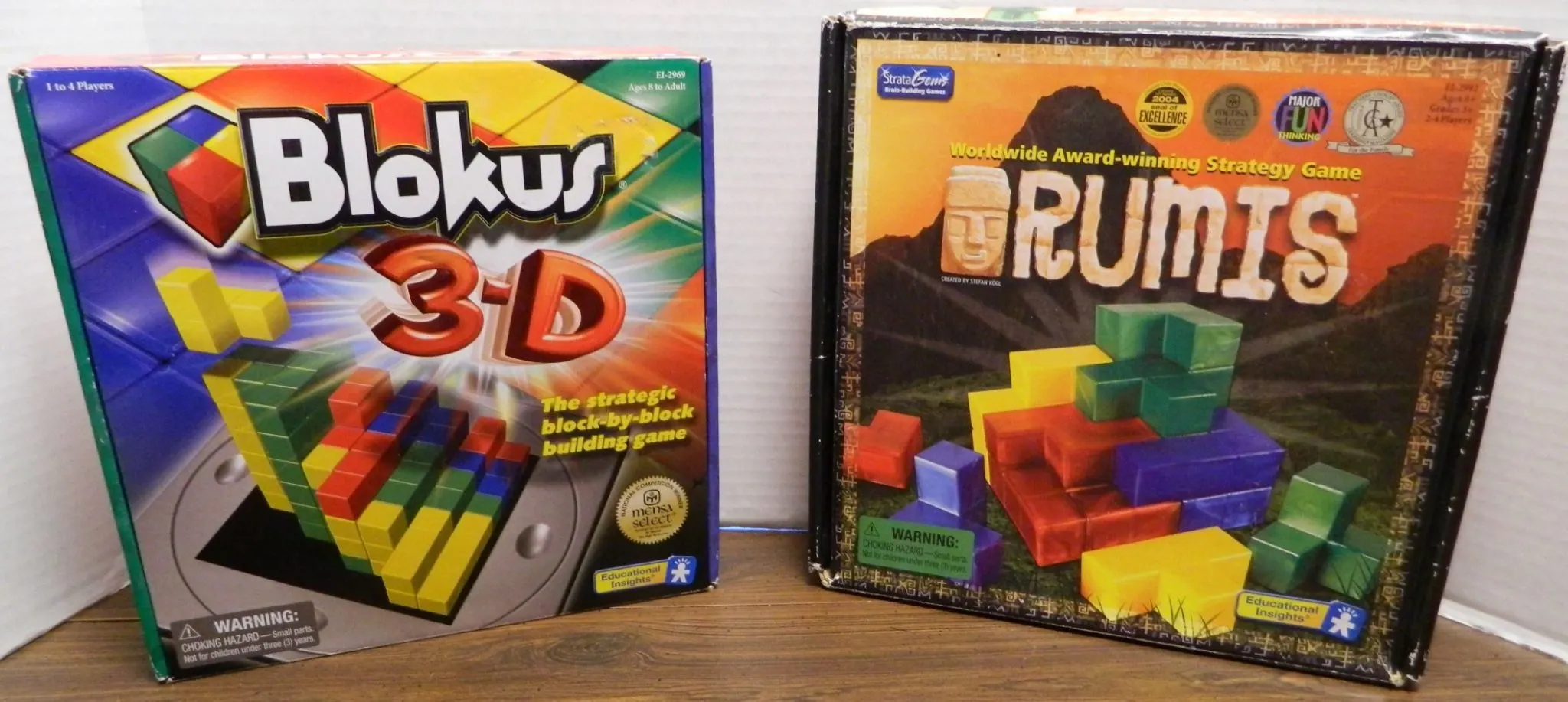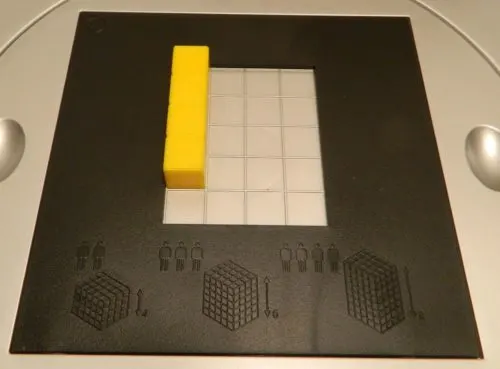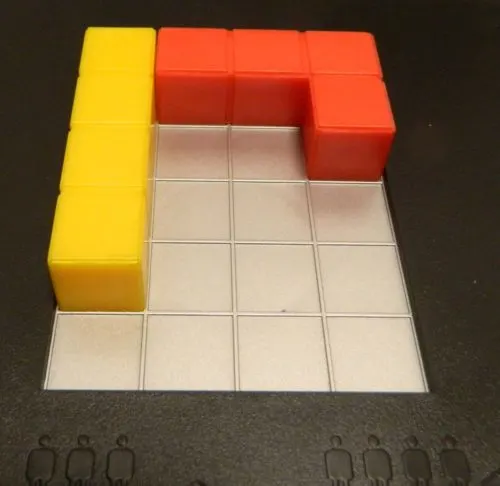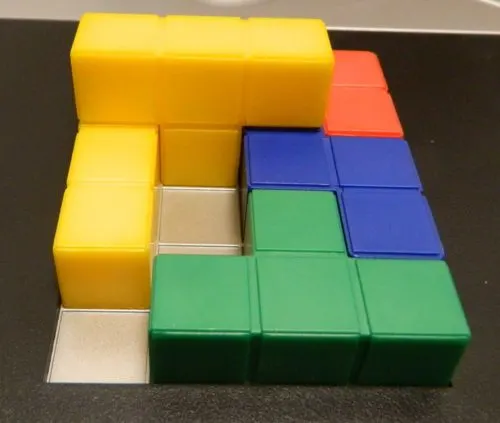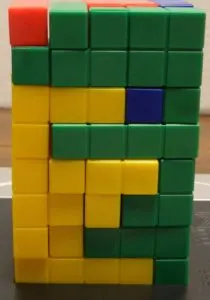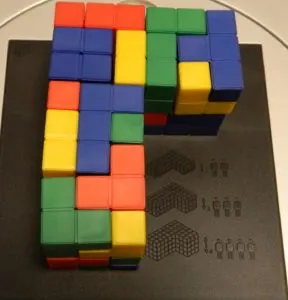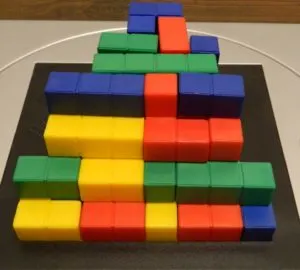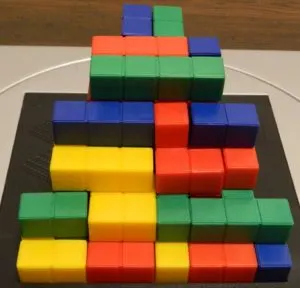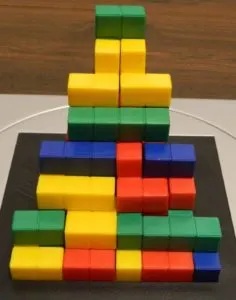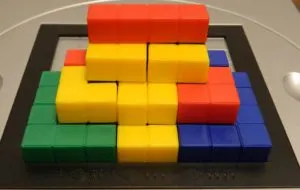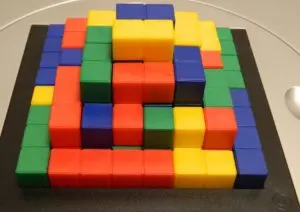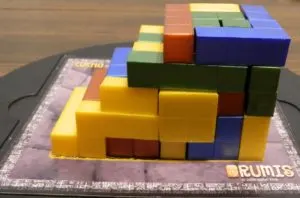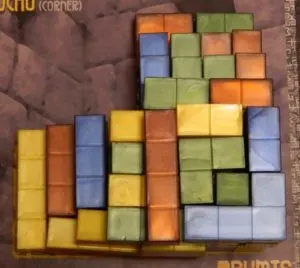Today instead of just one board game I am going to be taking a look at two games. Rumis was an abstract strategy game developed back in 2003 by Stefan Kögl. The objective of the game was for players to use 3D shapes to create different structures that would score them points for how many of their blocks were visible at the end of the game. I am not sure how well Rumis sold, but it must have had at least some moderate success as it was one of the recommended games for the 2003 Spiel Des Jahres. Rumis was successful enough that it had several different editions made over a few years. Released a couple years earlier Blokus filled a similar niche and quickly became a huge hit. In 2008 Educational Insights which owned the rights to both Blokus and Rumis decided to capitalize on the popularity of the Blokus brand and renamed Rumis into Blokus 3D only slightly changing the game in the process. As both games are basically the same I have decided to review them together in today’s review. Blokus 3D may be part of the Blokus franchise and share some things in common with other games in the franchise, but by adding the third dimension it creates its own unique game that fans of abstract strategy games should enjoy.
How to Play Blokus 3D/Rumis
Outside of a few slight differences Blokus 3D and Rumis are exactly the same game. Therefore this rules section will be written based on the Blokus 3D rules. Differences in the Rumis rules will be noted where needed.
Setup
- Each player chooses a color and takes all 11 blocks of that color.
- Place the gameboard in the middle of the table.
- Choose which template you would like to use and place it on the gameboard.
Playing the Game
The first player (the rules don’t specify how this is determined) will begin the game by placing one of their blocks on the gameboard.
The rest of the players will take their first turn by placing one of their blocks. The block must touch the gameboard and at least one of the blocks that have already been placed.
After everyone have placed their first block players will continue taking turns placing one block at a time. The additional rule that must be followed for each of these blocks is that each block that a player places must touch at least one other block of their color that they placed on a previous turn. The block can also touch blocks of other colors.
When placing blocks a number of other rules must be followed:
- A block cannot be placed if it violates the height restrictions of the structure that you are trying to build. For more information see the Structures section below.
- All of the squares of a block must line up with the structure’s grid.
- No part of a block can extend past the edges of the structure.
- When placing a block it cannot create a gap, hole or tunnel in the structure that can’t be filled in from above.
- If a player can play a block they must play it even if they don’t want to.
If on a player’s turn they cannot place a block they will no longer be able to place blocks for the rest of the game. Thus the player will skip their turn for the rest of the game.
End of Game
The game ends when none of the players have any more blocks that they can play.
To determine each player’s score you will look at the structure from above. Each player will score one point for each square of their color that is visible. Each player will also lose one point for each block that they were unable to add to the structure.
The player who scores the most points wins the game.
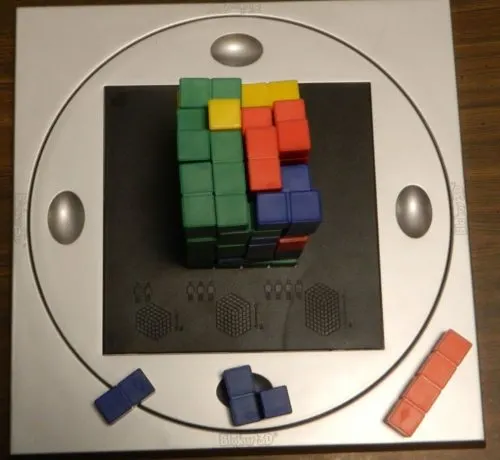
The game has ended. Players will score points based on their visible squares as follows: green – 9 points, yellow – 3 points, red – 5 points, and blue – 3 points. The blue player will lose two points as they were unable to play two of their pieces. The red player will lose one point. As the green player has scored the most points they have won the game.
Structures
Here are the different structures that you can use in Blokus 3D/Rumis and their various height restrictions. Note the pictures below do not necessarily follow the building rules as they are mostly used to illustrate what the final structures will look like.
Tower (Blokus 3D) / Chullpa (Rumis)
- 2 players – height 4
- 3 players – height 6
- 4 players – height 8
Corner (Blokus 3D) / Pirka (Rumis)
- 2 players- height 2
- 3 players – height 3
- 4 players – height 4
- 2 Players
- 3 Players
- 4 Players
Steps (Blokus 3D) / Pisac (Rumis)
- 2 players – height 4
- 3 players – height 5
- 4 players – height 8
- 2 Players
- 3-4 Players
Pyramid (Blokus 3D) / Coricancha (Rumis)
- 2 players – half pyramid, base 8 x 3, height 4
- 3 – 4 players – base 8 x 8
- 2 Players
- 4 Players
Cucho (Rumis)
- 2 players – height 3, play inside yellow border
- 3 players – height 3
- 4 players – height 5
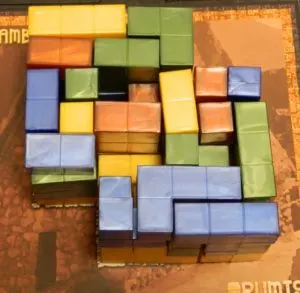
Note: All of the spaces in the structure could have been the same height. Some spaces in my picture are lower than others as there weren’t enough blocks to get each space to the maximum height.
Tambo (Rumis)
You may not place any block in the gap in the building plan.
- 2 players – height 2
- 3 players – height 3
- 4 players – height 4
Game Variations
One Player – For the one player game you try to build a 3 x 3 x 3, 4 x 4 x 4, or 5 x 5 x 5 color cube using the four colors and following the other rules of the game. You can also try to build a 3 x 3 x 3 cube with one color.
Two Players – For the two player game there are two options.
- The players can choose to use one color each. The game otherwise is the same with the player who scores more points from their color winning the game.
- The players can choose to both use two colors. With this selection the players will follow the height restrictions for a four player game. The players will alternate using a block from each of their colors. The player who scores the most points from one of their colors wins the game.
My Thoughts on Blokus 3D/Rumis
In the past I have taken a look at Blokus and Blokus Trigon. I enjoyed both games as they are good abstract strategy games that require players to do a good job visualizing how they can use their pieces to give themselves more play opportunities on future turns. While the two games have their own little tweaks they felt similar as the only significant difference between them is that each game uses different pieces. When I compare Blokus 3D to the other two Blokus games that I have played though it actually plays quite a bit differently. I am guessing that this is at least partially due to the fact that it started as Rumis and was eventually renamed to capitalize on the Blokus name.
Blokus 3D does fit into the same genre of games as the rest of the Blokus franchise as it emphasizes the same type of skills in order to do well. In the main Blokus games the goal is mostly to try and find a way to play all your pieces to the board as each you don’t play is worth negative points. Thus the objective of the game is to try to branch out your pieces as much as possible in order to give yourself more options later in the game. This is still the case in Blokus 3D/Rumis as well. You still lose points for each piece you don’t play. Spreading out your pieces is helpful since if you don’t you are going to really limit your options later in the game.
Outside of the obvious fact that you are building in 3D instead of on a flat surface, the main difference with Blokus 3D has to deal with the scoring. Unlike the other Blokus games you can actually score positive points outside of the bonuses for placing all of your blocks. To capitalize on the fact that you are building 3D structures you will score points based on how many of your colored squares are visible from the top of the structure. In my opinion this is what drives Blokus 3D’s gameplay. You want to play all your blocks to avoid the negative points, but it is much more important to score positive points from having your squares visible from above.
This aspect drives most of the game’s strategy. Each space on the gameboard has a designated height. With some of the structures the height is uniform while in others the spaces will have different max heights. I am not an expert in Blokus 3D, but the most obvious strategy appears to be trying to place pieces where you claim the top position on at least one of the spaces. By doing this you guarantee scoring the point for that space as no one can play a piece on top of it. You also need to spread out some to prevent yourself from being knocked out of the game. Most of your attention will likely go to placing pieces onto the spaces that will score you points though. In structures that have spaces with only a max height of one there will likely be a race between the players to take these spaces as they are free points.
As for how the game compares in difficulty to the other Blokus games I would say that for the most part Blokus 3D is actually easier. Based on the actual rules the game is slightly more difficult as there are a couple more rules that you have to keep track of which comes from building in 3D. The game might also require a little more visualization as you are building in 3D versus on a 2D plain. Otherwise I would say that Blokus 3D is easier. The game seems to give you a lot more options when playing your pieces as you can place a piece next to or on top of one of your other pieces. This seems to make it considerably easier to play most of if not all of your pieces. The punishment for not being able to play a piece is also significantly smaller allowing players to just focus on playing pieces that will score them points.
Additionally I think Blokus 3D plays quite a bit quicker than normal Blokus. Part of this is because the game is easier to play. Players don’t have to consider as much when playing pieces so they don’t waste as much time contemplating their turn. On top of this Blokus 3D gives each player almost half as many pieces. Unless you have a player that really suffers from analysis paralysis the game will likely move at a pretty brisk pace. I can’t see many games taking more than 15-20 minutes. This makes Blokus 3D a good filler game or it allows you to play a quick rematch.
While I liked Blokus 3D it shares one of the problems that the other Blokus games are well known for. Basically if two or more players work together they can pretty easily eliminate or significantly hurt another player. Two players could quickly build a sort of wall cutting off the other player preventing them from expanding out into other places on the board. I actually think this problem could be even worse in Blokus 3D than the other games. This is because instead of each player starting in their own section of the board each player’s first play has to touch another player’s piece. With players then playing pieces that touch their own pieces already out on the board they can create a solid wall instead of giving the player an escape path like in the other games. I actually think it is possible to eliminate a player within one or two turns if two players work together. For this reason turn order plays a pretty big role in the game as other player’s actions can have a pretty big impact on your fate in the game.
While Blokus 3D is different than Blokus in some somewhat significant ways, in many ways it still feels very similar. For this reason your opinion of the game is likely going to be very similar to your opinion of Blokus. If you have played and didn’t like Blokus I don’t see Blokus 3D being any different. Those who are fans of Blokus or other similar abstract strategy games will likely enjoy Blokus 3D as well. I am not a huge fan of abstract strategy games, but I like Blokus 3D. I would say that it is on par with the other Blokus games that I have played. The game does a good job balancing accessibility and strategy. It is really easy to play, but your choices will play a pretty big role in who ultimately wins. You need to have a long term plan of where you plan on playing your next pieces as you want to leave yourself with options to keep playing pieces and claiming more spaces that will score you points. I wouldn’t play Blokus 3D all the time, but I think it will work well as a filler abstract strategy game that you bring out every so often.
For most of this review I have referred to the game as Blokus 3D and I have mostly done that because that is the game’s most recent name and the name that people are more likely to recognize. Everything that I have discussed so far applies to Rumis as well as these elements are exactly the same between the two games. So what are the differences between the two games besides the name? Basically the differences come down entirely to the components. The major difference between the two games is the fact that Rumis includes two additional structures (Tambo and Cucho) that you can create which aren’t present in Blokus 3D.
Otherwise the differences come down to the components themselves. The blocks for both games are made of plastic except for some versions of Rumis, outside of the United States, which apparently use wood. The blocks for Rumis are about 10-20% larger than Blokus 3D’s which is a benefit in my opinion as it makes the structures more stable. Blokus 3D’s pieces have more distinct grooves in them though which allows them to fit into grooves in the gameboard. I also think Blokus 3D does a better job with the templates as it is easier to tell what structure you are trying to make. Personally there are things that I prefer about each game’s components as both have pretty good components. The thing that ultimately makes me side with Rumis though is the fact that it includes the two additional structures.
Speaking of the number of structures you should get plenty of games out of the included structures before you start tiring of them. At that point you actually have a few options. First there is actually a sequel of sorts for Rumis called Rumis+ which includes six additional structures that you can build along with pieces to support six players. Otherwise Blokus 3D/Rumis have a pretty big fanbase who have developed their own structures over the years. If you check out the game’s BoardGameGeek page you can actually find quite a few fan made structures that can be downloaded for free.
Should You Buy Blokus 3D/Rumis?
Blokus 3D may share a name with the Blokus franchise, but it is not exactly the same as other games from the franchise. The overall feel is familiar as you will have to use many of the same strategies in order to succeed in the game. Adding the third dimension adds some interesting new ideas to the game. While it is still important to play as many of your pieces as possible, it is also important to play pieces in a way where they will score you points. This makes Blokus 3D feel different from other games in the franchise. There are new strategic options to consider, but it also seems to make the game a little easier and quicker to play. I found Blokus 3D to be a fun game even if it isn’t something that I would play all the time.
My recommendation basically comes down to your opinion of the Blokus franchise and abstract strategy games in general. If you don’t really care about either I don’t see it being for you. Fans of the Blokus franchise that think the idea of a 3D version of the game sounds interesting though are likely to enjoy the game. Whether you should pick up Blokus 3D or Rumis depends on whether you want the additional boards or if you prefer the Blokus 3D components. Fans of abstract strategy games should consider picking up one of the two games though as I think they should enjoy the game.
Buy Blokus 3D/Rumis online: Amazon (Blokus 3D, Rumis
), eBay (Blokus 3D
, Rumis
)

